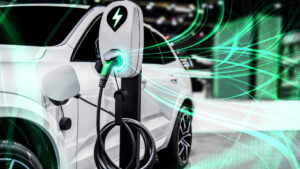Strategic Elements advances self-charging battery technology

Strategic Elements is working with CSIRO and UNSW to develop self-charging, micro-battery cells. (Picture: Getty Images)
Special Report: Self-charging battery technology that can create electricity from humidity in the air or the skin’s surface is being developed by Strategic Elements and its research partners.
Strategic Elements Limited (ASX:SOR) through its subsidiary Australian Advanced Materials (AAM) has teamed up with the University of New South Wales and CSIRO for the $1m project.
Battery cells created with printable ink using AAM’s 3D-printer technology are self-charging within minutes and do not require any extra manual charging or wired power.
“Early stage results are extremely promising as we apply years of experience and intellectual property in electronic inks into the development of a battery ink that generates electricity from the environment,” managing director Charles Murphy said.
The battery ink is developed from AAM’s Nanocube Memory Ink technology with an advanced graphene oxide material and is the company’s intellectual property.
Graphene oxide is formed from the oxidation of graphite and is able to harvest energy from external factors such as moisture and heat.
Graphite is relatively cheap and readily available as a material and as an oxide it disperses in water.
Internet of Things devices require micro-sized, lightweight batteries
The battery technology is ideally suited for Internet of Things devices and generates electricity from humidity in the air or from the surface of human skin.
IOT devices such as wearable technology, medical devices, smart meters, home automation products and sensors are all driving growth in the battery market.
This means there is a growing need for thin and flexible micro battery technology.
The company expects the global battery market for IOT devices to be worth $US15.9bn ($22.3bn) by 2025.
“From the Automated Robotic Security Vehicle we are building with US giant Honeywell, the ongoing commercialisation of the Nanocube Memory Ink, this new development in battery ink and other commercial activities on the horizon, Strategic Elements is generating significant momentum,” said Murphy.
Nanocube Memory Ink is a transparent ink containing billions of nanometre scale particles that can be printed onto a surface. Electrodes operate as computer memory.
Competitive advantages of Battery Cell Ink technology
Battery Ink Cells have several competitive advantages when compared with lithium-based batteries that require a constant power source to recharge and are heavier.
These advantages include its quick self-charging feature, flexibility, non-flammable material, extreme light weight and thinness and lack of environmental issues.
In early stage work to date with graphene oxide ink at the University of NSW, a world leader in electronic materials engineering, the company has made significant progress.
The tam has fabricated more than 100 battery cells by coating graphene oxide onto glass, clocked a self-charging time of 3 minutes for a battery cell using water vapour, and produced a battery cell thinner than a human hair.
The next stage of the team’s work over the next 12 weeks at UNSW will focus on three factors.
The optimisation of the battery cell ink formulation, scaling up production of battery ink to at least 1 litre, and developing a successful prototype connecting several battery cells that produces at least 3.7 volts.
Battery Cell Ink technology project supported by Australian government
The research work is being carried out under the Australian Research Council, which is part funding the $1m budget for the project.
The expected outcome of the project is new electronic materials for a wide range of uses in flexible electronics and significant advances in energy efficient data storage devices.
Intellectual property and commercialisation rights in the project remain with AAM.
Investors in Strategic Element’s shares pay no tax on potential capital gains under a federal government program to encourage investment in innovation.
The Australian government has registered the company as a Pooled Development Fund with a mandate to back Australian innovation.
This article was developed in collaboration with Strategic Elements, a Stockhead advertiser at the time of publishing.
This article does not constitute financial product advice. You should consider obtaining independent advice before making any financial decisions.
Related Topics
UNLOCK INSIGHTS
Discover the untold stories of emerging ASX stocks.
Daily news and expert analysis, it's free to subscribe.
By proceeding, you confirm you understand that we handle personal information in accordance with our Privacy Policy.








